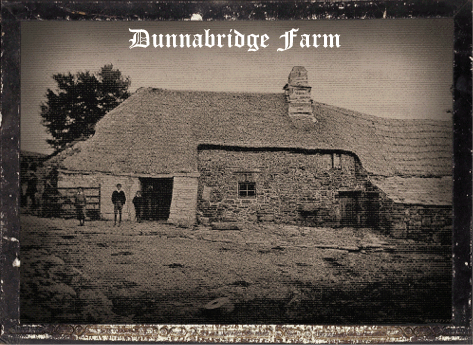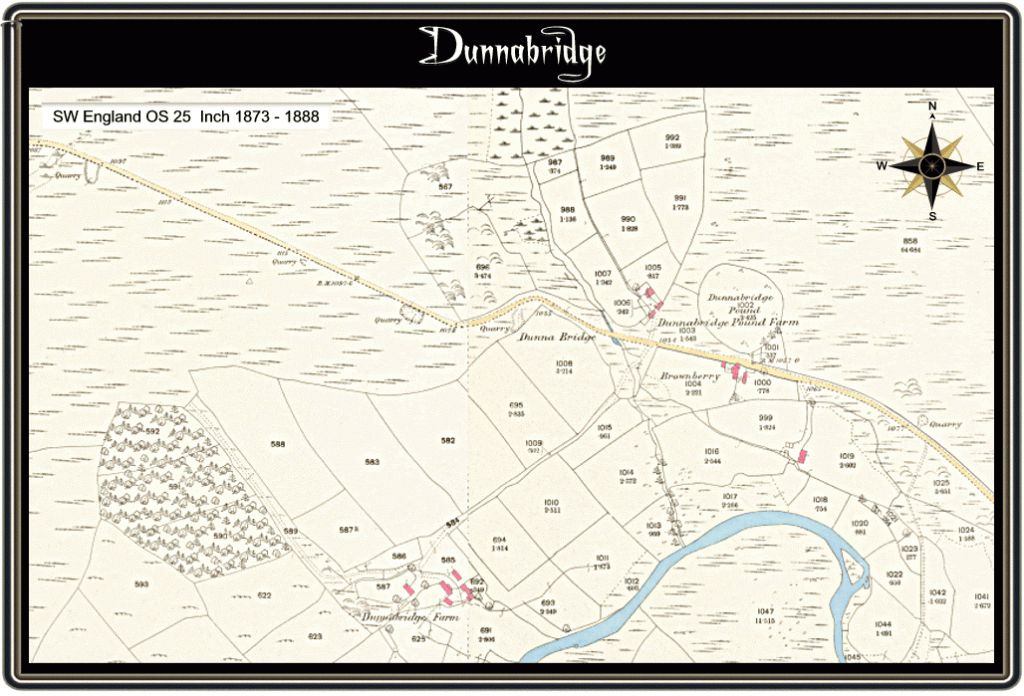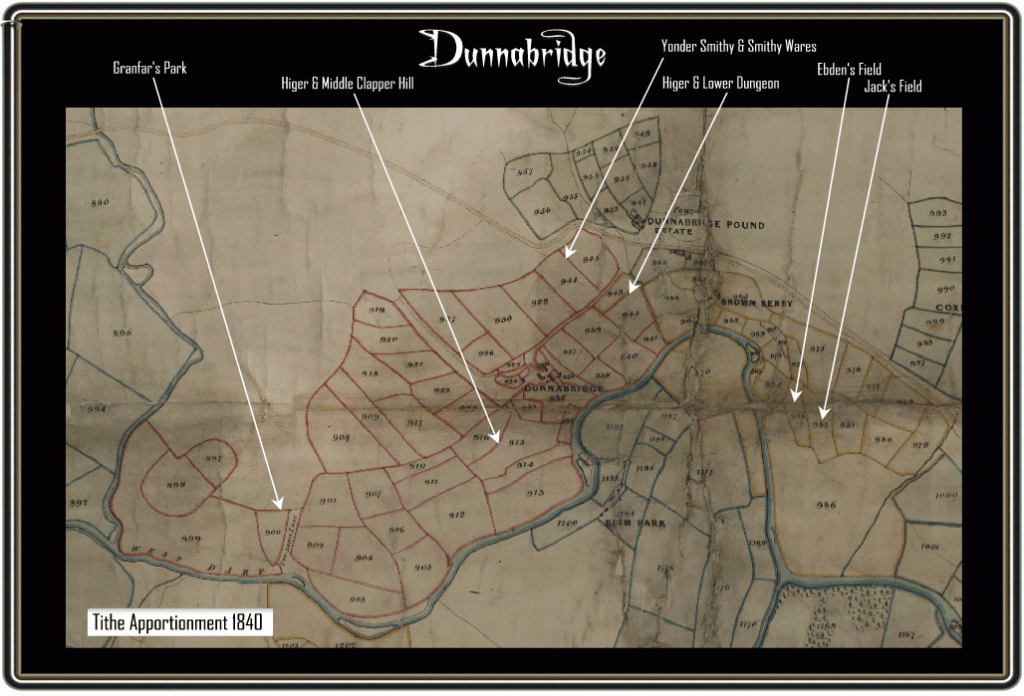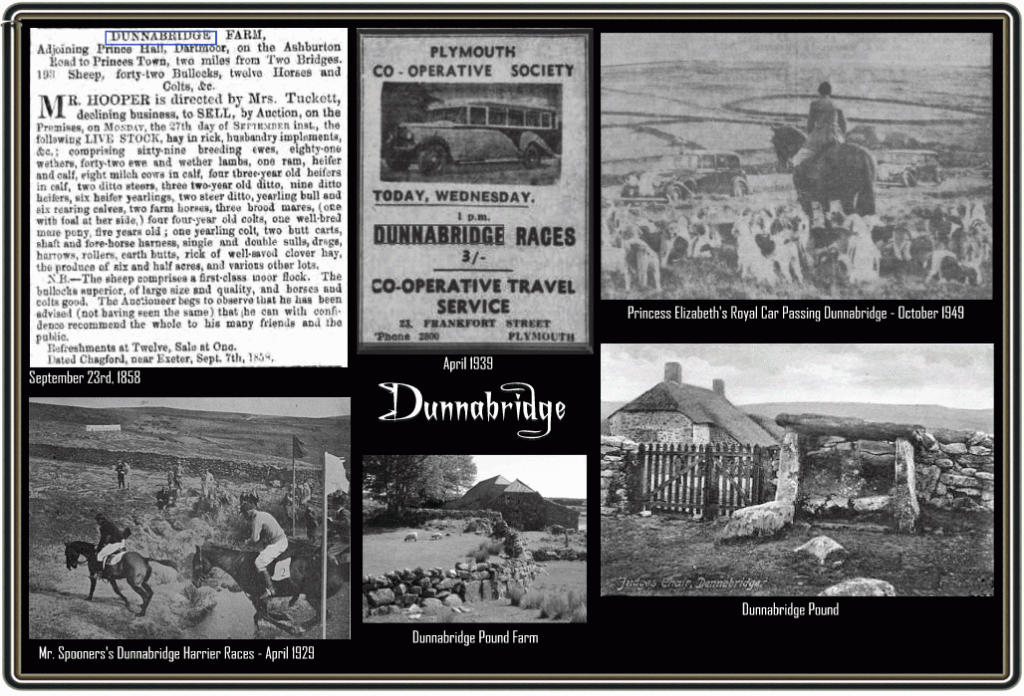
Mention the word ‘Dunnabridge‘ and possibly the first thing that springs to mind is the historic (and prehistoric) ‘Dunnabridge Pound‘. However, there have been and also are such place-names as; Dunna Bridge (The), Dunnabridge Farm, Dunnabridge Newtake, Dunnabridge Plantation, Dunnabridge Moor, Dunnabridge Steps, Dunnabridge Ford, Dunnabridge Pound Farm, Dunnabridge Common, Dunnabridge Bog and Dunnabridge Pound Water. All of these locations are concentrated in a fairly small area but over the years there has been a surprising host of events and ‘doings’ in and around the locality.
It is a known fact that Dunnabridge Pound dates back to the Bronze Age and a couple of discoveries have reinforced that fact. In the April of 1905 whilst cutting turf at Dunnabridge Bog Mr. F. Coaker discovered a pristine flint arrowhead some 18 inches below the surface. Again in 1940 Miss Anne Coaker discovered a kistvaen in Dunnabridge Newtake whilst burning off some furze. Sadly the kist had been robbed with only the western side stone standing, it was also located in a small but again much robbed cairn.
So let’s have a look at the actual place-name which historically points to very early beginnings. According to Gover et al, p.193, the earliest written record of Dunnabridge appears in a Duchy of Cornwall document of 1305 where it appears as Donebrigge and is taken to mean – ‘Bridge by the down’, which they suggest to have be spanning the West Dart river. The modern-day bridge that crosses the Dunna Brook is a fairly recent addition and therefore could not be the bridge ‘by the down’ as can be seen later.
The first recorded evidence of human occupation in the area was the ancient tenement farm of Donebrugge in 1305 which today is Dunnabridge Farm. The history of the farm as detailed by the Pastscape Record reads; “rent was payable from “3 ferlings of land” containing 96 acres “at Donnebrug. The land was let in equal parts to five named tenants. There were still five tenements in 1786; four of them were held by Thomas Leaman and one by John Leaman. In 1839, four of the tenements were still occupied by the Leaman family. By 1841 Richard Tuckett lived at Dunnabridge; he farmed 195 acres and in 1851 he employed five male servants whose ages ranged from eight to eighteen years. By 1861 the Tuckett family were living at Dunnabridge Pound and George French had taken Dunnabridge. In 1910 Dunnabridge Farm, occupied by F. Turner, consisted of nearly 197 acres, a house and “adequate” outbuildings.” It is interesting to look at the tithe apportionment of 1840 when Richard Tucker was occupying the farm leased by Thomas Leaman with regards to some field names (see map below). You have ‘Granfar’s Park’ which is adjacent to ‘Two Pence Lane’. In theory at some time in the past the small one acre plot called ‘Granfar’s Park was in the possession of somebody’s grandfather. With regards to ‘Two Pence Lane’ there is a mystery, it certainly has the appearance of a stroll where livestock would be gathered but as to why ‘Two Pence Lane’ I have no idea? You also have ‘Higher and Middle Clapper Hill’ enclosures which suggests that somewhere nearby was once a clapper bridge. To the N.N.E. of the farm are two enclosures called ‘Higher and Lower Dungeon’ and as the area was always a favourite spot for the local foxhounds it would possibly mean that the word ‘Dungeon’ refers to a foxes holt or den. As a foxy aside, there was some excitement in the November of 1937 when the local hounds chased a fox into Dunnabridge Woods, in a frantic attempt to escape the sly old ‘Charlie‘ climbed to the top of a tall fir tree. One of the hounds rashly climbed up after it and as soon it got within reach the fox climbed back down and made its bid for freedom. Unfortunately the hound couldn’t get back down and then had to be rescued with the aid of a rope. – The Western Times, November 26th, 1937. Finally, and this is pure speculation there are another two enclosures called ‘Yonder Smithy’ and ‘Smithy Wares’, could this indicate that at some time a blacksmith’s forge was nearby? A Pastscape Record associated with Dunnabridge Farm suggests that in enclosure number 902 on the tithe map is a pillow mound, if this is so it would suggest that at some point in time rabbits were being bred here. “SX 63637379. A disturbed turf-covered mound lies on the crest of a south-facing slope in rough grassland. It is apparently composed of soil, though a few stones are evident at the foot of the mound on the downhill side. It measures 5.7m long, 3.2m wide and is 0.6m in height. No trace of a ditch was detected otherwise it is comparable in both size and slope to pillow mounds near the foot of Roundhill, above the West Dart River.” – online source HERE

At Dunnabridge Farm in the June of 1854 there was a case of what today is known as TWOCing or ‘taking without consent’ only it did not involve a motor vehicle but a horse belonging to Ann Tuckett. At the time a worker at the farm namely one William Veasey, alias Territt was asked to drive some cattle to market on one of her horses. For some reason when he got near Buckfastleigh he put the cattle into a field and took himself to a local public house. Whether or not he had run out of money nobody knows but for some reason he sold the horse to a local miner called John Smetham for £3.10s which was at least half its worth. Much later in the day when the horse had not been returned to the farm the police were notified and a search for both the missing horse and man got underway. Finally Veasey/Territt was captured in another public house at Bridgetown in Totnes when he confessed his guilt to the arresting constable. – The Western Times, July 8th, 1854.
On the 19th of August 1928 the Reverend Williams of the small Wiltshire town of Cricklade with his wife and family were camping at Dunnabridge Farm. On this day the reverend took his two sons down to the West Dart river to paddle. Having enjoyed some time at the river he returned with his younger son to the campsite for lunch whilst leaving his eldest son Richard to finish putting on his shoes and socks. After a while it was noticed that his son had not returned so the reverend went back to the pool to make sure his son was safe. Tragically he found the nine year old boy standing upright in Hurdle Pool and despite efforts of artificial respiration the boy was pronounced dead. It was thought that he had climbed a nearby wall accidentally overbalanced and fallen back into the water, the verdict at the inquest was accidental drowning. Shortly after this sad occurrence in 1929 a granite memorial cross fashioned by Messrs. Caunter of Dunnabridge Farm and Mr. Worth was erected near to the spot.
March 2001 saw what was to be the beginning of one of the most recent tragedies in the history of Dartmoor’s Livestock farming. It was in this month that there was a confirmed outbreak of Foot and Mouth Disease on Dunnabridge Farm. The result of this being that 300 sheep and 170 beef cattle had to be slaughtered on the farm and an additional 127 sheep who were grazing on nearby moorland were also slaughtered as being dangerous contact animals. It did not take long for other Dartmoor farms to be effected which resulted to much of Dartmoor becoming a ‘no go area’. At the time I was living just outside Chagford and we could smell the stench of the carcasses being burnt at a location just outside Okehampton which as the crow flies was a good 16 kilometres away.
Now to the ‘bridge’ question, as noted above it has been suggested that the original bridge referenced in 1305 spanned the West Dart river. But what about the modern bridge that carries the B3357 road over the Dunna Brook (AKA Dunnabridge Pound Water)? In the May of 1876 a special vestry meeting was held at the Saracen’s Head (now the Two Bridges Hotel) where Mr. T Coaker, the Lydford waywarden presented a resolution to the effect that a bridge should be built over the brook. The estimated cost of the new bridge was £50.00 with the parish paying half of the bill and the County Bridge Committee the other half. This proposal was accepted provided the Highway Board approved and construction was to have been subject to the approval of the County Surveyor. As can be seen today this was approved although prior to construction the estimated cost had risen to £70.00. – Tavistock Gazette, May 26th, 1876. In the September of 1876 it was reported at a meeting of the Highway Board that the new bridge at Dunnabridge Pound had been completed.
Again, as noted above by 1861 the Tuckett family had moved from Dunnabridge Farm to Dunnabridge Pound Farm and it was Dinah/Diana Tuckett who was the pound keeper. It is interesting to see from the sale notice what livestock and equipment was up for auction prior to moving from Dunnabridge Farm to Dunnabridge Pound Farm – see below. Dinah was certainly not a woman to be tangled with and quite capable of matching any mans swearing. Hemery relates how; “A moorman from the Chagford area recalled for me a ride he had had, as a small boy, with his father to Dunnabridge to claim some impounded ponies; unfortunately, his father forgot his money bag, and no amount of pleading could persuade Dinah to unlock the pound gate for him. The moorman’s patience dissolved, and he became abusive, the response in blue language from Dinah at once caused him to withdraw, and with his astonished son, he rode off to borrow the pound dues from an acquaintance at a nearby farm.” p.444. Another modern-day reminder of Dinah comes in the form of an alternative name for the small shelter inside Dunnabridge Pound, some folk still refer to this as ‘Dinah’s Chair’ (others the Judge’s Chair). As pound keeper there would have been times when she had to attend the pound and in inclement weather this would be where she sat and took shelter – hence ‘Dinah’s Chair’.
Obviously to be a pound keeper one had to be very robust and thick skinned as the average keeper of livestock was none to happy paying to redeem their animals. During the late 1800s it was the normal practice to firstly keep any animals collected at the drift in the enclosure at Merrivale Bridge for a day. But in 1884 it was reported that 150 cattle were immediately driven to Dunnabridge Pound in order foil any attempt of reclaiming and livestock before entering the pound, this ruse worked and all the cattle were safely ensconced in the pound. Apart from being a Dartmoor ‘legend’ Dinah Tuckett was know in Royal circles. In the June of 1936 the Duchy tenants were presented to King Edward and the first in line was 68 year old Dinah Tuckett. Apparently the King shook hand with her and gave his condolences for the recent loss of her brother. The following year she was presented to King George where she related to him; “I am the pound keeper at Dunnabridge and I have been working there for 53 years come Lady Day. Please give my love to the Queen and the little Princesses. I hope they are well.” It was also reported at the time that only one one occasion had she ever been away from her cottage at Dunnabridge and that was in 1914. – Western Morning News, December 2nd, 1937.
Since the 1920s Dunnabridge has been famous for it’s point to point races organised by Mr. Spooner’s Harriers. This event provided all the thrills and spills of a moorland point to point race and as can be seen below the most popular fence was the water jump. In 1929 there was a typical ‘spill’ when; “Lieutenant-Colonel F. J. Dunlop came to grief much to his embarrassment. His horse refused the jump and threw him off which ended up in him getting completely submerged, after extracting himself he emptied his bowler hat of water with a smile and retired gracefully. Probably much to his embarrassment and the glee of his subordinates his exploits were later reported in the Western Morning Times. Being located on such an exposed site the races were often subject to the vagaries of the Dartmoor weather. Probably one of the worst occasions was on the 27th of April, 1950 when in the morning over three inches of snow covered the ground. Luckily by the time the event started most of it had disappeared. However, for the rest of the day both riders and spectators were treated to a mixture of heavy rain, sleet and hail. As can be seen below spectators arrived by every means including motor cars, organised bus parties etc, in 1950 the cost of car parking was £1 per vehicle. Just like Ascot great interest in the fashions of the day were a talking point. In 1939 the ‘in thing’ was clearly checked jackets and coats with younger girls wearing “gaily covered handkerchiefs over their curls and bright slickers.” Also at this same meeting the famous comedian George Formby attended with his wife and a party of friends, it seems his fame went before him and after being recognised too much he donned a pair of dark glasses as a disguise. As it was an overcast day would not the glasses made him even more conspicuous?
As with any race meeting there is always the opportunity for some people to make a fast buck and Dunnabridge Point to Point was no exception. In 1935 Mr. Frederick Bolt placed a 12 shilling bet on a horse called Jill with one George Smedley. Much to Bolt’s excitement ‘Jill’ won the race and so he hurried off to collect his winnings. However, despite an exhaustive search Smedley was nowhere to be found and so the matter was reported to the police. They soon arrested Smedley who was identified in an identification parade and charged him with stealing and carrying away the money. Also one Ernest Phillips and one Alfred Brown were also arrested and charged with aiding and abetting Smedley. When he finally appeared at the Devon Quarter Sessions it transpired that previous to this crime he had a host of previous convictions including; stealing £3,000 worth of furs from a warehouse, demanding money by menaces and five convictions for wounding and assault. Despite pleading innocent to the charge he was sentenced to four months imprisonment for ‘welshing’ on Bolt’s bet and stealing his money.
Whilst on the subject of criminals Dunnabridge had been the scene of several instances involving escaped convicts from nearby Dartmoor Prison. In 1884 a convict named Bray managed to escape when a thick fog enveloped the prison. Whilst working in the prison yard he took this opportunity to climb over the prison wall and ‘do one’. A warder named Kelly spotted his escape and as the prisoner made of across a field fired a shot at him, unfortunately missing his target. Immediately the flag was raised on the signal station and after recalling all remaining convicts to the prison a search party of fifty officers was dispatched to recapture the man. They managed to track Bray by the imprints of the broad arrows on the soles of his boots as far as Two Bridges where they lost his trail. Later that afternoon a Mr. Tucker from Princetown was walking across the moor when he came across a man who on seeing him immediately bolted off. Later that evening one of the Tuckett men came across Kelly at Dunnabridge. Unfortunately for the escapee Tuckett was one of Devonshire’s noted wrestlers. Initially Tuckett asked the man where he was going and was told; “home to Chudleigh.” Tuckett realising he was an escapee then kindly offered to escort him just in case he got lost, this offer was quickly refined. Tuckett then said; “Well, you will have to come with me anyway,” and with that grabbed Kelly and in true wrestling style threw him to the ground. A tussle ensued after which Bray managed to regain his feet but once again he was unceremoniously dumped back on the ground. The convict the began throwing stones at Tuckett to which his reply was to whack Bray on the head with his stick. Another brawl ensued the upshot being that Bray screamed; “You’re killing me,” and seemingly fell unconscious. Taking this advantage of summoning help Tuckett went to fetch his father and brothers but no sooner had he walked away than Bray shot up and dashed away to freedom. The next sighting of the convict was in a plantation at Holne Chase. One of the footmen was shooting rabbits in the woods when he came across the prisoner and asked what he was doing. Bray replied; “Don’t want any rabbits or birds.” With that he he jumped over an hedge and once again made a break for freedom. Bray was not seen for some time but for some odd reason he was recaptured back at Princetown when he was caught picking pockets. – Exeter & Plymouth Gazette, July 25th, 1884.
In 1946 two German prisoners of war escaped from a camp at Stoke Gabriel and managed to get as far as Dunnabridge. Clearly tired, wet and hungry they called at Dunnabridge Pound Farm and asked for a cup of tea and something to eat. As the men were still in uniform they were recognised as prisoners of war and the police were contacted. The men were then taken to Princetown police station and afterwards transferred to Tavistock where they spent the night before being returned to the prisoner of war camp.
In 1949 one John Francis Atkinson was serving a sentence for larceny and housebreaking at Princetown Prison where he worked in the prison hospital. On the 24th of April whilst all the convicts were attending chapel Atkinson made his escape. After bending some thick metal bars he pushed a pair of steps through the gap and climbed through it, he then placed the steps against the 25 foot outer wall, scaled it and made off across the moor. Prior to escaping he had changed from his prison uniform into white trousers and a green shirt which he had previously made himself. It did not take long for the alarm to be raised and some 20 prison officers set off in pursuit of him. After an hour’s chase over about eight miles the escapee finally collapsed at, yes you’ve guessed it, Dunnabridge. When the prisoner officers finally caught up with him he drew a knife which he probably had stolen from the hospital and threatened his captors. Fortunately he was soon disarmed without any injury and returned to prison. – Herald Express, April 25th, 1949.
So what does all this prove? The area covered in this location is roughly one tiny square kilometre of Dartmoor, some of which is open moorland and others agricultural enclosures along with what once was three family homes. I am also sure there are a host of events and stories that I have not come across in this brief spell of research. However, it does go to prove that since prehistoric times man, in one shape or form, has woven a lasting tapestry of ‘doings’ in such a small area and one that will continue to grow as time goes on.


Gover, J. E. B., Mawer, A. & Stenton, F. M. 1992 The Place Names of Devon, English Place-Name Society, Nottingham.
Hemery, E. 1983. High Dartmoor. London: Robert Hale.
 Legendary Dartmoor The many aspects past and present of Dartmoor
Legendary Dartmoor The many aspects past and present of Dartmoor




Thank you for the very interesting article
A great site. Love the Labbie